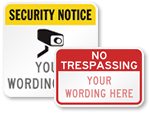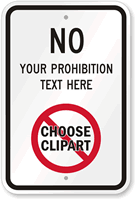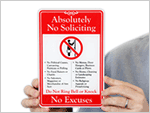There once existed a time in history when students were believed to be America’s most vivacious and energetic people. However, because of the increasing amounts of drug and alcohol abuse, that time is long gone. Eighty percent of high school students have admitted to have had some sort of interaction with drugs whether it was witnessing, using, or dealing them. Although anti-drug campaigns such as “Just Say No” and “My Anti-Drug” have attempted to reduce the use of drugs by teenagers, the number of teenagers abusing drugs is still staying relatively high. The legalization of medicinal marijuana seems to simply be adding fuel to the fire by giving teenagers an excuse to use the drug. Help students say no to drugs and remain in school with
Drug Free School Zone Signs.
Almost a quarter of adults in the United States
smoke cigarettes, with over 47 million people in the U.S. deeming themselves “smokers.” Nonetheless, marijuana use is more prevalent than cigarette smoking among high-schoolers: 21.4% of high school seniors smoked marijuana in the last month, over 2% more than had smoked cigarettes. The adverse effects of marijuana are especially dangerous to teenagers and students whose brains are still developing. The drug interferes with memory, sensation, and perception, which in turn causes a loss of self-control and distorts the ability to synthesize information, a skill extremely necessary in an educational environment. The widespread abuse of drugs disrupts a child’s motivation and determination for learning. According to research, students were twice as likely to receive D’s and F’s if they were using marijuana than those students who chose to abstain. Furthermore, experimentation with marijuana inspires experimentation with other drugs in that teenagers recognize the synthetic thoughts and feelings associated with drugs. One study showed that one’s exposure to other drugs and/or
alcohol increases the chances that that individual will begin to use marijuana. Another study proves that the greater involvement a student has with marijuana, the more likely he/she will want to try other drugs; and the vicious cycle continues.
No Drugs Signs can help shield children from addictive drugs and prevent the vicious cycle before it even starts.
The most common influence of drugs among teenagers is social influence. Whether it comes from television, movies, or peers, “feeling older” or “fitting in with others” is the most common stimulus for teens to try drugs, rather than exploring the actual effect or feeling from the drug. For this reason First Lady Nancy Reagan championed the anti-drug campaign, “Just Say No,” aimed at educating the youth on the effects of drugs. By having students and adolescents, rather than adult supervisors, organize the projects which were canvassed across the country, the campaign helped decrease the percentage of high school seniors smoking marijuana from over 50% in 1978 to 36% in 1988, to a
mere 12% in 1991. The positive effect was not prevalent among all anti-drug campaigns however. The “My Anti-Drug” campaign, which encourages teens to find a deviation to their drug addiction increased marijuana and drug use. The campaign sent the wrong message to students that other teens were acceptably using drugs. The campaign engendered a sense of inclusiveness for the students and rendered that others were going through a similar struggle. The program, instead increased drug exposure and distorted students’ perceptions of other’s appropriate use of marijuana. The reason behind “Just Say No”’s success is that it increased drug use awareness and the extreme consequences from drug abuse on a public level using the media to capture the country’s attention. Installing signs such as
No Alcohol or Drugs Permitted on School Property” will likewise increase public awareness in schools and will have a similar dwindling effect to the “Just Say No” campaign.
The legalization of medicinal marijuana, which came about in 1996 with California pioneering as the first state, was highly controversial in the effects it would have on teen’s abuse of the drug. Since then, fifteen more states have followed suit and ten more are in the process to permit the use of the drug for health purposes. Many believe it has caused a decrease in teen use of marijuana. While studies show a national decrease in teen drug abuse from 1999 to 2006, the decrease is less than 1% and in some states the numbers have even risen. There still exist hundreds of teens who are using the drug for non-medicinal purposes, risking their health. A quarter of doctors polled even disagreed with the legalization of the drug, believing the cons outweigh the pros and that the drug is still detrimental towards our health. The British Lung Foundation compared the dangers of marijuana cigarettes to
tobacco ones and found that 3-4 of the former were analogous to 20 of the latter, once again portraying the level of damage marijuana can have. Paranoia, psychosis, and lung failure are just a few of the threats to one’s physical health, not to mention the mental and psychological damage. If
schools don’t buckle down and strengthen their supervision on students, the situation will remain stagnant and we will continue to witness teenagers abusing drugs.












